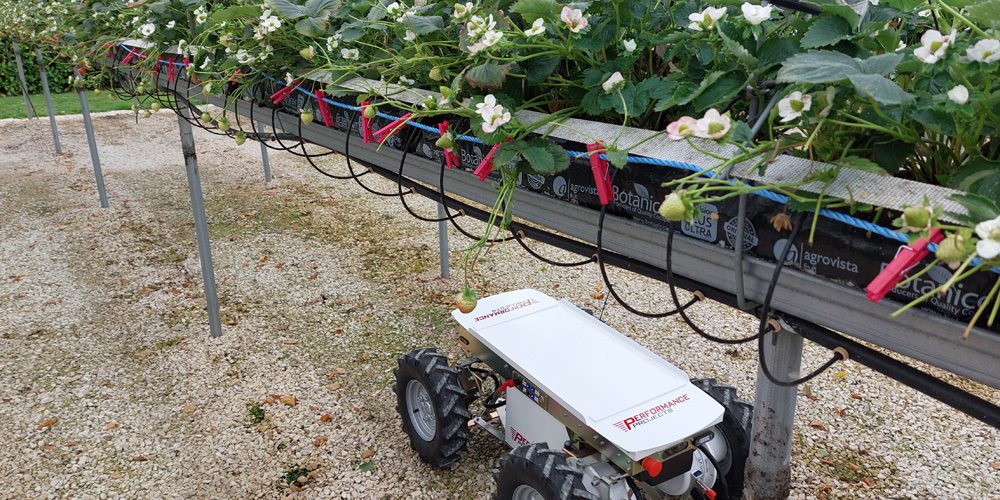Home » Need for seed: Formula One know-how is helping build a better tractor
Need for seed: Formula One know-how is helping build a better tractor

Techniques used in race car design help Performance Projects’ GoFAR farming robot chug through mud, wind and rain.
The last time Chris Horton was in Toronto he was trying to coax cars to reach 177 kilometres an hour. Back in the early 2000s, Horton was working for British engine-maker Cosworth and was here helping a Canadian racing car team amp up the velocity of their high-performance vehicles. “It was all about design, calibration and working trackside to get the most out of the engines and the drivers,” he says.
Two decades later, Horton is back in Canada and is working on another cutting-edge machine. He’s taking part in a special initiative of MaRS and Innovate UK to bring companies with manufacturing know-how across the pond to Canada. But this time his focus isn’t Formula One. It’s farming.
Horton is the founder of Performance Projects, an engineering consultancy and maker of concept vehicles. The company is based at the U.K.’s illustrious Silverstone racetrack and produces components for ultra-fast hypercars (as well designs for innovative projects like this donut-shaped taxi). But with farmers under pressure from labour shortages, climate change and soaring demand for protein, Horton has set his sights on the booming market for agricultural machinery. Performance Projects has developed a rugged little robot called GoFAR, which it hopes might soon be a fixture in the fields.
Small but mighty
GoFAR is a curious machine. It stands only about a foot off the ground and has four chunky wheels fixed to a sturdy frame. It’s clearly designed for some heavy-duty off-road work, but it’s not immediately obvious what that might be. It isn’t equipped with the usual robotic gizmos like cameras and arms; instead it ends abruptly above the wheels in a flat surface. The overall effect is of a Mars rover carrying an ironing board.
GoFAR’s unusual appearance stems from the fact that it is deliberately only half-finished. Horton calls it a “vanilla” platform that is designed to be kitted out with whatever robotic accessories a customer needs. “We provide the vehicle, and you can plug in whatever automation you want and whatever implements and sensors you need to deliver a service.”
Two prototypes are currently being tested by the University of Lincoln to see how well they navigate around indoor commercial growing spaces. In the summer, the researchers will use them to cart produce from fields to central weigh stations, relieving pickers of this time-consuming task. Longer-term, Performance Projects expects farmers to put the platform to more ambitious uses, such as equipping it with LiDAR and cameras to monitor crop growth or attaching a mechanical weeder and setting it to constantly patrol the fields.

From racetrack to dirt track
Horton is a rarity in the world of autonomous vehicles. Entrepreneurs working on robots and self-driving cars tend to speak the language of computer-vision systems and machine learning. But Horton is a mechanical engineer through and through — his vocabulary is all torque, drive lines and powertrains. And that perspective is his selling point.
“There’s a lot of money going into AI and sensors but the vehicle itself is often not a core part of the investment,” he says. “Development work is done with very lightweight vehicles — like an e-scooter — because they’re cheap. They’re fine for proving a concept, but they’re not right for building a service that might have to run in all conditions over extended periods. That’s where our vehicles come in — they give that reliability.”
Horton sees a particularly good opportunity in Ontario’s agriculture sector, where durability is top of mind for farmers. They need equipment that can chug through mud, wind, rain, ice, heatwaves and countless other adversities. As part of the MaRS-Innovate UK collaboration, Performance Projects has been connecting with local producers.
While tending crops may seem like a dramatic change of pace from the gasoline-and-adrenaline world of motorsport, Horton says there are plenty of crossovers. Both require an excellent understanding of the operating conditions and need for high-spec designs to cope with demanding environments. And both take skill to rapidly build and iterate on prototypes.
But above all, says Horton, both are irresistibly tricky engineering challenges. “As engineers, we really want to get involved with solving big problems.”
Learn more about how MaRS and Innovate UK are bringing new breakthroughs to Canada.
Photography: Courtesy of Performance Projects
MaRS Discovery District
https://www.marsdd.com/
MaRS is the world's largest urban innovation hub in Toronto that supports startups in the health, cleantech, fintech, and enterprise sectors. When MaRS opened in 2005 this concept of urban innovation was an untested theory. Today, it’s reshaping cities around the world. MaRS has been at the forefront of a wave of change that extends from Melbourne to Amsterdam and runs through San Francisco, London, Medellín, Los Angeles, Paris and New York. These global cities are now striving to create what we have in Toronto: a dense innovation district that co-locates universities, startups, corporates and investors. In this increasingly competitive landscape, scale matters more than ever – the best talent is attracted to the brightest innovation hotspots.


